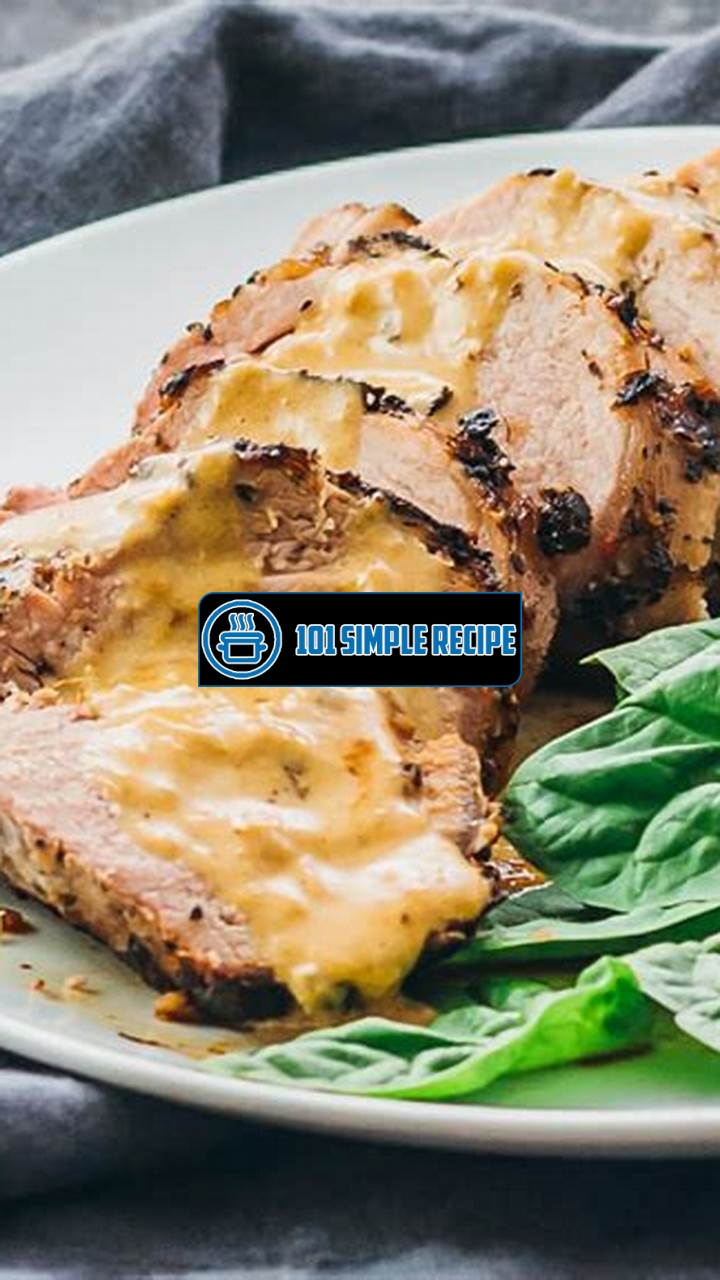Are you craving a tender and juicy pork tenderloin but not sure how long to roast it for that perfect result? Look no further, as we have the answer to your question! Whether you are planning a sumptuous dinner for two or a family feast, knowing the ideal roasting time is crucial. A 1 lb pork tenderloin can turn into a mouthwatering delight with just the right amount of time in the oven. In this article, we will guide you through the process of roasting a 1 lb pork tenderloin to perfection. So, put on your apron, preheat your oven, and let’s get cooking! ️

The Perfect Pork Tenderloin: Cooking Time and Techniques
Discover the secrets to roasting a succulent 1 lb pork tenderloin, from understanding the cut to mastering the ideal cooking time.
Understanding Pork Tenderloin
Before you start roasting a 1 lb pork tenderloin, it’s important to understand the cut itself. Pork tenderloin is a lean and tender piece of meat that comes from the muscle running alongside the backbone of the pig. It is long and thin in shape, making it perfect for roasting. It is also one of the most versatile cuts of pork, allowing for a variety of cooking techniques and flavors.
When cooking pork tenderloin, it’s crucial to keep in mind that it should be cooked to an internal temperature of 145°F (63°C) for medium-rare or 160°F (71°C) for medium. This will ensure that it is safe to eat while keeping the meat moist and tender.
Selecting the Best Pork Tenderloin
Choosing the right pork tenderloin is essential for achieving the perfect roast. Look for a tenderloin that is firm to the touch, with a pinkish color and a marbling of fat throughout. Avoid any tenderloins that have a strong smell or feel slimy, as these are signs of spoilage.
When selecting a 1 lb pork tenderloin, ensure that it is uniform in thickness and size. This will ensure even cooking and prevent any part of the tenderloin from drying out or becoming overcooked. Remember to remove any excess silver skin or fat from the surface of the meat before cooking.
Prepping the Pork Tenderloin
Before roasting your 1 lb pork tenderloin, it’s important to properly prepare it. Begin by preheating your oven to 425°F (220°C) to ensure a hot cooking environment. While the oven is preheating, season the tenderloin with your desired spices and seasonings. Popular options include garlic powder, paprika, thyme, and rosemary.
Next, heat a skillet over medium-high heat and add a small amount of oil. Sear the tenderloin on all sides until it develops a golden brown crust. This step adds flavor and helps to lock in the juices. Transfer the seared tenderloin to a roasting pan or baking dish and place it in the preheated oven.
Cook the 1 lb pork tenderloin for approximately 20-25 minutes, or until the internal temperature reaches 145°F (63°C) for medium-rare or 160°F (71°C) for medium. Remember to use a meat thermometer to ensure accurate cooking. Once the desired temperature is reached, remove the tenderloin from the oven and let it rest for 5-10 minutes before slicing. This resting period allows the juices to redistribute, resulting in a juicy and flavorful roast.
Now that you know the secrets to roasting a succulent 1 lb pork tenderloin, you can confidently prepare this delicious cut of meat for your next meal. Whether you’re serving it for a weeknight dinner or a special occasion, your perfectly cooked pork tenderloin is sure to impress!
Peanut butter cup recipe can be a tasty dessert option after enjoying your pork tenderloin.
The Role of Cooking Time in Roasting
When it comes to roasting a pork tenderloin, the cooking time plays a crucial role in determining the texture and flavor of the final dish. Achieving the perfect doneness requires careful consideration of various factors such as the size of the tenderloin, the oven temperature, and even the desired level of doneness.
The Science Behind Cooking Time
The cooking time for a 1 lb pork tenderloin is influenced by the principles of heat transfer. As the tenderloin is placed in a preheated oven, heat is conducted from the oven’s heating elements to the exterior of the meat. From there, the heat gradually penetrates the interior, cooking the tenderloin from the outside-in.
The internal temperature of the pork tenderloin is a key factor in determining doneness. As the meat cooks, the proteins denature, fats melt, and connective tissues break down, resulting in a tender and flavorful dish. However, if the meat is undercooked, it may be tough and unappetizing, while overcooking can lead to dryness and loss of flavor.
Factors Affecting Cooking Time
Several factors can significantly affect the cooking time of a 1 lb pork tenderloin:
- Tenderloin Size: The weight and thickness of the tenderloin play a crucial role in determining cooking time. A 1 lb tenderloin will generally require less time than a larger cut of meat.
- Oven Temperature: The temperature at which the tenderloin is roasted directly influences the cooking time. Higher temperatures will cook the tenderloin more quickly, while lower temperatures will require a longer cooking time.
- Desired Doneness: The level of doneness you prefer will also affect the cooking time. If you prefer a medium-rare tenderloin, it will require less time than a well-done one.
It’s essential to consider these factors when determining the optimal cooking time for your 1 lb pork tenderloin. While there are general guidelines available, it’s recommended to rely on a meat thermometer to ensure accurate results and avoid under or overcooking.
Measuring Pork Tenderloin Doneness
To accurately measure the doneness of your 1 lb pork tenderloin, a meat thermometer is a valuable tool. Insert the thermometer into the thickest part of the meat, making sure it doesn’t touch any bones or the cooking pan. The target internal temperature for pork tenderloin is around 145°F (63°C) for medium-rare to medium doneness.
Additionally, another method to determine doneness is by visually examining the meat. A properly cooked pork tenderloin should have a slightly pink and juicy center. However, it’s crucial to ensure that the meat is cooked thoroughly to prevent any foodborne illness.
In conclusion,
Understanding the role of cooking time in roasting a 1 lb pork tenderloin is essential for achieving the perfect texture and flavor. By considering factors such as tenderloin size, oven temperature, and desired level of doneness, you can ensure a delicious and tender dish every time. Remember to rely on a meat thermometer or visual cues to accurately measure doneness and enjoy a mouthwatering pork tenderloin that will impress your guests.
Roasting Techniques and Temperature
Master the art of roasting pork tenderloin as we delve into the different methods and ideal cooking temperatures.
Slow Roasting: Low and Slow
When it comes to cooking a 1 lb pork tenderloin, one of the most popular techniques is slow roasting. This method involves cooking the pork at a low temperature for an extended period of time, resulting in tender and flavorful meat.
To achieve the perfect slow-roasted pork tenderloin, preheat your oven to 325°F (163°C). Season the tenderloin with your favorite herbs and spices, such as garlic powder, paprika, and thyme. Place the seasoned meat on a roasting rack set inside a shallow baking dish, ensuring that there is space around the tenderloin for heat circulation.
The key to slow roasting is patience. Cook the pork for approximately 25-30 minutes per pound, or until the internal temperature reaches 145°F (63°C). Remember to use a meat thermometer to ensure accuracy. Once cooked, let the pork rest for 5-10 minutes before slicing.
Slow roasting allows the flavors to develop slowly and evenly, resulting in a tender and succulent pork tenderloin. The low temperature ensures that the meat cooks through without drying out, making it a foolproof method for beginner cooks.
High Heat Roasting: Quick and Crispy
If you’re short on time but still want a deliciously crispy pork tenderloin, high heat roasting is the technique for you. This method involves cooking the pork at a higher temperature for a shorter amount of time, resulting in a caramelized crust and juicy interior.
To achieve the perfect high heat-roasted pork tenderloin, preheat your oven to 450°F (232°C). Season the tenderloin with salt, pepper, and any additional spices of your choice. Place the seasoned meat on a roasting pan or baking sheet lined with parchment paper.
Roast the pork at high heat for approximately 15-20 minutes, or until the internal temperature reaches 145°F (63°C). The higher temperature will help create a beautiful crust on the outside while sealing in the juices inside. Remember to let the pork rest for a few minutes before slicing to allow the juices to redistribute.
High heat roasting is a great option when you’re in a hurry but still want a flavorful and crispy pork tenderloin. The shorter cooking time ensures that the meat remains juicy and tender, perfect for a quick and satisfying meal.
Reverse Searing: The Best of Both Worlds
For those who want the best of both worlds—tender, juicy meat and a crispy exterior—reverse searing is the technique to try. This method involves slow roasting the pork tenderloin first, followed by a quick sear to achieve that desired crust.
To reverse sear a 1 lb pork tenderloin, start by preheating your oven to 275°F (135°C). Season the meat with your favorite herbs and spices, and place it on a roasting rack set inside a baking dish. Slow roast the tenderloin for approximately 30-40 minutes, or until the internal temperature reaches 125°F (52°C).
Once the desired temperature is reached, remove the pork from the oven and let it rest for a few minutes. Meanwhile, heat up a skillet with a small amount of oil over high heat. When the oil is hot, carefully sear the tenderloin for 1-2 minutes per side, or until a crust forms.
The reverse searing method allows the meat to cook slowly and evenly, resulting in a tender and flavorful pork tenderloin. The final sear adds that coveted crispy exterior, creating a texture contrast that will impress your taste buds.
In conclusion, mastering the art of roasting a 1 lb pork tenderloin comes down to choosing the right technique and cooking temperature. Whether you prefer slow roasting, high heat roasting, or the best of both worlds with reverse searing, each method offers a unique and delicious result. So, pick your favorite technique, gather your ingredients, and get ready to enjoy a mouthwatering pork tenderloin that will leave you craving for more.
Kaiser rolls go perfectly with pork tenderloin for sandwiches.
The Role of Resting and Carving
When it comes to cooking a delicious and tender pork tenderloin, there are two important factors that can make all the difference: resting and carving. These aspects play a crucial role in ensuring that your pork is juicy, tender, and full of flavor. In this article, we will uncover the importance of resting your roasted pork tenderloin and discuss the proper carving techniques that will result in picture-perfect pork slices.
Resting for Juiciness and Tenderness
Resting your pork tenderloin after it is roasted is essential for achieving optimal juiciness and tenderness. Once the pork is removed from the oven, allow it to rest for at least 5 to 10 minutes before carving. This resting period allows the juices to redistribute throughout the meat, resulting in a moist and flavorful final product. During this time, the internal temperature of the pork will continue to rise slightly, ensuring that it is cooked to perfection.
While the pork is resting, it’s crucial to cover it with foil to retain heat. Wrapping it tightly in foil will help keep the meat warm and prevent it from drying out. This step is especially important for larger cuts of meat, such as a 1 lb pork tenderloin, as it allows the fibers to relax and the flavors to settle.
Furthermore, resting your pork tenderloin also makes it easier to carve. The meat becomes more firm and stable, preventing it from falling apart during the carving process. This leads us to our next subtopic, which is the proper carving techniques to achieve picture-perfect pork slices.
Carving Techniques for Picture-Perfect Pork
Carving pork tenderloin requires some skill and knowledge to achieve the best results. By following the proper carving techniques, you can ensure that each slice is tender, juicy, and visually appealing.
Start by using a sharp carving knife or a serrated knife. This will allow you to make precise cuts without tearing the meat. Begin by cutting perpendicular to the grain, creating slices that are about 1/2 inch thick. Avoid applying too much pressure while slicing, as it can cause the juices to escape and result in dry meat.
When it comes to serving the pork, arrange the slices on a platter or a serving dish. If you prefer, you can also fan out the slices, creating an elegant presentation. Remember to work quickly while carving and serving the pork to ensure that it stays warm and juicy.
Now that you have mastered the art of resting and carving your pork tenderloin, it’s time to take the flavor to the next level by exploring pan sauces.
Enhancing Flavor with Pan Sauces
One way to elevate the taste of your pork tenderloin is by complementing it with a delicious pan sauce. Pan sauces add depth and complexity to the dish, enhancing the overall flavor profile.
After you have finished roasting and resting your pork, there will be flavorful drippings and browned bits left in the roasting pan. To make a pan sauce, start by deglazing the pan with a liquid such as wine, broth, or vinegar. Scrape the bottom of the pan to release all the tasty caramelized bits, which will infuse the sauce with rich flavors.
Once the liquid has reduced slightly, you can add additional ingredients like herbs, spices, and aromatics to customize the sauce to your liking. Simmer the sauce until it reaches a desired consistency, then strain it to remove any solids. Pour the sauce over your sliced pork tenderloin or serve it on the side as a dipping sauce.
With the addition of a flavorful pan sauce, your pork tenderloin will truly shine, impressing your family and guests with its succulent taste.
Remember, resting and carving are key steps in achieving the perfect pork tenderloin. By allowing the meat to rest and practicing proper carving techniques, you can ensure that each bite is tender, juicy, and bursting with flavor. Don’t forget to elevate your dish further with the addition of a delicious pan sauce. Now go ahead and roast that 1 lb pork tenderloin to perfection!
Troubleshooting and Tips for Perfect Roasting
In the quest for the perfect roasted pork tenderloin, various issues may arise that can affect the outcome of your dish. But fear not! With these expert tips and tricks, you can overcome common hurdles and achieve foolproof results every time.
Overcooking and Dryness Prevention
One of the most common issues when roasting pork tenderloin is overcooking, resulting in dry, tough meat. To avoid this, it’s essential to closely monitor the cooking time and temperature.
An ideal guideline for roasting a 1 lb pork tenderloin is approximately 20 minutes at 400°F. However, it’s crucial to rely on a meat thermometer to determine the doneness accurately. The internal temperature should reach 145°F for perfectly cooked and juicy pork tenderloin.
Pro Tip: Invest in a reliable meat thermometer to ensure accurate temperature readings and avoid the risk of under or overcooking.
Another way to prevent dryness is to properly season and marinate the pork tenderloin before roasting. Seasonings not only add flavor but also help to retain moisture in the meat. A simple and delicious marinade can be made with olive oil, garlic, salt, pepper, and herbs of your choice.
Pro Tip: Marinate the pork tenderloin for at least 30 minutes or up to overnight to allow the flavors to penetrate and enhance the taste.
Seasoning and Flavor Enhancements
Seasoning plays a crucial role in elevating the flavors of roasted pork tenderloin. While salt and pepper are essential components, don’t be afraid to experiment with various herbs and spices to add depth and complexity to your dish.
Popular options include rosemary, thyme, garlic powder, paprika, and cumin. You can create a dry rub by mixing these spices together or use them individually to suit your preferences.
Pro Tip: Gently pat the pork tenderloin dry before applying the seasoning to ensure it adheres well and enhances the overall taste.
For an extra burst of flavor, consider glazing the pork tenderloin during the roasting process. A simple glaze made with honey, Dijon mustard, and soy sauce can add a deliciously sweet and tangy element to the meat.
Pro Tip: Brush the glaze onto the pork tenderloin during the final 10 minutes of roasting to prevent burning and achieve a glossy, caramelized finish.
Leftovers and The Next Day
It’s quite common to have leftovers when roasting a 1 lb pork tenderloin. Fortunately, there are numerous ways to repurpose and enjoy the remaining meat the next day.
Pro Tip: Store the leftover pork tenderloin in an airtight container in the refrigerator to maintain its freshness and quality.
One option is to slice the leftover pork tenderloin and use it as a protein-rich addition to salads. The tender and flavorful meat can elevate the simple salad to a satisfying and nutritious meal.
Another idea is to incorporate the leftovers into sandwiches or wraps. Layer them with your favorite toppings and condiments for a tasty and convenient lunch option.
Pro Tip: To prevent the meat from drying out during reheating, add a splash of broth or a drizzle of olive oil to the leftovers before heating them in the oven or microwave.
Lastly, you can always freeze the leftover pork tenderloin for future use. Wrap it tightly in plastic wrap and place it in a freezer bag. When ready to use, thaw it overnight in the refrigerator before reheating or incorporating it into your desired dishes.
Pro Tip: Label the frozen pork tenderloin with the date to keep track of its freshness.
With these troubleshooting tips and expert advice, you’re now equipped to roast a perfect 1 lb pork tenderloin every time. Say goodbye to dryness and hello to tender, flavorful meat that will impress your family and friends!
Hoisin sauce recipe can be a delicious addition to your roasted pork tenderloin.
Frequently Asked Questions
Here are some common questions about roasting a 1 lb pork tenderloin:
| No. | Questions | Answers |
|---|---|---|
| 1. | How long does it take to roast a 1 lb pork tenderloin? | The cooking time for a 1 lb pork tenderloin will vary depending on your preferred doneness. As a guideline, roast it in a preheated oven at 425°F (220°C) for approximately 20-25 minutes until the internal temperature reaches 145°F (63°C) for medium-rare or 160°F (71°C) for medium. Use a meat thermometer to ensure accuracy. |
| 2. | Should I marinate the pork tenderloin before roasting? | Marinating the pork tenderloin before roasting is optional but highly recommended. A marinade adds flavor and helps to tenderize the meat. You can marinate the pork tenderloin for at least 30 minutes up to overnight in the refrigerator for best results. |
| 3. | Do I need to sear the pork tenderloin before roasting? | Searing the pork tenderloin before roasting is another optional step. Searing creates a flavorful crust on the outside of the meat. Heat a skillet with some oil over high heat and sear all sides of the pork tenderloin until browned before transferring it to the oven. |
| 4. | Should I cover the pork tenderloin with foil while roasting? | It is not necessary to cover the pork tenderloin with foil while roasting. Leaving it uncovered allows the heat to circulate evenly and promotes browning. However, if you notice the top of the pork tenderloin getting too brown while cooking, you can tent it with foil for the remainder of the cooking time. |
| 5. | How do I know when the pork tenderloin is done? | The best way to determine if the pork tenderloin is cooked to your desired doneness is by using a meat thermometer. Insert the thermometer into the thickest part of the tenderloin, and it should read 145°F (63°C) for medium-rare or 160°F (71°C) for medium. Let the meat rest for a few minutes before slicing. |
| 6. | How should I season the pork tenderloin? | Seasoning the pork tenderloin is a matter of personal preference. A simple seasoning of salt, pepper, and garlic powder works well, but you can also experiment with other herbs and spices. Rub the seasoning onto the pork tenderloin before roasting for the flavors to penetrate the meat. |
Thanks for Reading! Come Back for More Roasting Tips!
We hope this article has provided you with the information you need to roast a delicious 1 lb pork tenderloin. Whether you’re a seasoned cook or just starting out in the kitchen, our goal is to help you create mouthwatering meals. If you have any more questions or need further assistance, feel free to visit our website again. Happy roasting!
Jump to Recipe
Roasted 1 lb Pork Tenderloin

Learn how to roast a tender and juicy 1 lb pork tenderloin with this easy recipe. Perfect for any occasion!
- 1 lb pork tenderloin
- 2 tsp olive oil
- 1 tsp salt
- 1/2 tsp black pepper
- 1/2 tsp garlic powder
- Preheat the oven to 425°F (220°C).
- Rub the pork tenderloin with olive oil, salt, pepper, and garlic powder, ensuring all sides are well coated.
- Place the seasoned pork tenderloin on a roasting rack or baking sheet. Roast in the preheated oven for 20-25 minutes, or until the internal temperature reaches 145°F (63°C) for medium-rare or 160°F (71°C) for medium. Use a meat thermometer to check the temperature.
- Remove the pork tenderloin from the oven and let it rest for 5 minutes before slicing. This allows the juices to redistribute.
- Slice the pork tenderloin into medallions and serve with your favorite side dishes.
- Enjoy your perfectly roasted 1 lb pork tenderloin!






